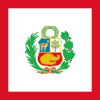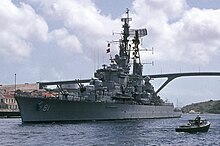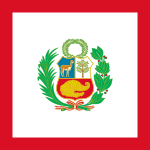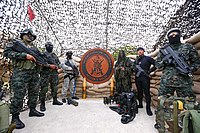
A | B | C | D | E | F | G | H | CH | I | J | K | L | M | N | O | P | Q | R | S | T | U | V | W | X | Y | Z | 0 | 1 | 2 | 3 | 4 | 5 | 6 | 7 | 8 | 9
| Peruvian Navy | |
|---|---|
| Marina de Guerra del Perú | |
 Coat of arms of the Peruvian Navy | |
| Founded | 8 October 1821 |
| Branch | Navy |
| Size | 25,988 active personnel 51 ships, 43 aircraft |
| Naval headquarters | Callao naval base, Peru |
| Patron | Miguel Grau Seminario |
| Anniversaries | October 8 – Navy's Foundation Day and Anniversary of the Battle of Angamos |
| Fleet | 6 Submarines 7 Frigates 7 Corvettes 7 patrol ships 1 Landing Platform, Dock 2 landing ships, tank 6 River gunboats 2 Training Ships 25 Auxiliaries |
| Engagements | |
| Commanders | |
| General Commander of the Navy | |
| Insignia | |
| Flag |  |
| Naval ensign |  |
| Naval jack |  |
| Standard |  |
| Roundel |  |
| Low-visibility roundel |  |
The Peruvian Navy (Spanish: Marina de Guerra del Perú, abbreviated MGP) is the branch of the Peruvian Armed Forces tasked with surveillance, patrol and defense on lakes, rivers and the Pacific Ocean up to 200 nautical miles (370 km; 230 mi) from the Peruvian littoral. Additional missions include assistance in safeguarding internal security, conducting disaster relief operations and participating in international peacekeeping operations.
The Marina de Guerra del Perú celebrates the anniversary of its creation in 1821 on October 8 and also commemorates the decisive Battle of Angamos, the final part of the naval campaign of the War of the Pacific between Peru and Chile at the end of 1879.
History
19th century

The Marina de Guerra del Perú was established on 8 October 1821 by the government of general José de San Martín. Its first actions were undertaken during the War of Independence (1821–1824) using captured Spanish warships. The Peruvian Naval Infantry was also formed during the war with Spain, performing successfully in their first battle where they seized Arica from the Spanish.[2]
Shortly afterwards it was engaged in the war against the Gran Colombia (1828–1829) during which it conducted a blockade against the seaport of Guayaquil and then assisted in the subsequent Peruvian occupation. The Navy saw further action during the war of the Peru-Bolivian Confederacy (1836–1839) and during the Chincha Islands War with Spain (1866).
The breakout of the War of the Pacific (1879–1883) caught the Peruvian Navy unprepared and with inferior forces in comparison to the Chilean Navy. Even so, hit-and-run tactics carried out by Peruvian Admiral Miguel Grau, commander of the ironclad Huáscar, famously delayed the Chilean advance by six months until his death and defeat at the Battle of Angamos.
20th century
Following the War of the Pacific, the Peruvian Navy had to be completely rebuilt. In 1900 the force consisted of only one cruiser of 1,700 tons displacement, a screw-driven steamer, and ten smaller ships – the latter described by a contemporary British publication as "of no real value".[3] The lengthy process of expansion and rebuilding started in 1907 with the acquisition from the United Kingdom of the scout cruisers Almirante Grau and Coronel Bolognesi, followed by the arrival of two submarines, Ferré and Palacios, from France in 1911. During the Presidency of Augusto B. Leguía (1919–1930) a Navy Ministry was established as well as a Navy Aviation Corps, both in 1920.

Border conflicts with Colombia in 1911 and 1932 and a war with Ecuador in 1941 saw Peruvian warships involved in some skirmishes in support of the Army. The attack on Pearl Harbor brought World War II to the Pacific and even though Peru did not declare war on the Axis until 1945, its Navy was involved in patrol missions against possible threats by the Imperial Japanese Navy from early 1942 up to mid-1945.
During the 1970s and the first half of the 1980s the Peruvian Navy carried out a major buildup programme[4] which allowed it to take advantage over its traditional rival, the Chilean Navy. The navy purchased one cruiser the BAP Almirante Grau (CLM-81) from the Netherlands, eight Carvajal-class frigates from Italy – four newly purchased and four ex-Lupo-class frigates – as well as six PR-72P-class corvettes from France. The buildup proved to be temporary due to the economic crisis of the second half of the 1980s, forcing the decommissioning of several warships and resulting in a general lack of funds for maintenance.
The economic upturn of the 1990s and into the 2000s would later permit some improvement, although at a reduced force level compared to the early 1980s.[citation needed]
21st century

Into the 21st century, the Peruvian Navy began to modernize their ships. In 2008, the Type 209/1100 submarines were modernized[5] while the Carvajal-class frigates began to be modernized in 2011.[6] The Type 209/1200 submarines began to be modernized in late-2017 beginning with the BAP Chipana (SS-34).[5]
SIMA has continued to construct ships for the Navy. In 2013, SIMA partnered with Posco Daewoo Corporation and Daesun Shipbuilding of South Korea to construct two Makassar-class landing platform docks.[7] The BAP Pisco (AMP-156), recently launched on 25 April 2017, as well as the BAP Paita which is currently under construction will provide Peru with increased expeditionary warfare capabilities, with the ability to accommodate multiple Landing Craft Vehicle Personnel, newly purchased LAV IIs and helicopters.[7][8]
In 2018, a modernization program was initiated to upgrade Peru's Type 209/1200 submarines, the BAP Chipana, BAP Angamos, BAP Antofagasta and BAP Pisagua, with a contract with ThyssenKrupp Marine Systems being made for further assistance with SIMA.[9]
During the 2017–present Peruvian political crisis, the Navy of Peru was involved in political scandals. During the first impeachment process against president Martín Vizcarra, the next in the order of succession to the presidency, President of the Congress Manuel Merino, had been in contact with the Commanding General of the Navy saying that he was attempting to remove Vizcarra from office.[10] While the 2021 Peruvian general election was underway, the imprisoned former head of the National Intelligence Service (SIN) Vladimiro Montesinos was able to make phone calls from a landline telephone at the Centro de Reclusión de Máxima Seguridad (CEREC) at the Callao Naval Base to organize projects and campaign support for Keiko Fujimori in the Vladi-audios scandal.[11][12][13]
Organization
| Peruvian Navy |
|---|
 |
| History |
| Ships |
| Insignia |
| Organisation |
The current Commander-in-Chief of the Peruvian Navy is Admiral Alberto Alcalá Luna. Naval Forces are subordinated to the Ministry of Defense and ultimately to the President as Chief Supreme of the Peruvian Armed Forces. They are organized as follows:
- Comandancia General de la Marina (Navy General Command)
- Estado Mayor General de la Marina (Navy General Staff)
- Inspectoría General de la Marina (Navy General Inspectorate)
Operational units are divided between three commands:
- Comandancia General de Operaciones del Pacífico
Pacific Operations General Command, it comprises the following units:
- Fuerza de Superficie (Surface Force)
- Fuerza de Submarinos (Submarine Force)
- Fuerza de Aviación Naval (Naval Aviation Force)
- Fuerza de Infantería de Marina (Naval Infantry Force)
- Fuerza de Operaciones Especiales (Special Operations Force)
- Comandancia General de Operaciones de la Amazonía
Amazon Operations General Command, tasked with river patrolling in the Peruvian portion of the Amazon Basin.
- Dirección General de Capitanías y Guardacostas
Directive General of Captains and Coast Guard, oversees Coast Guard operations
Coast Guard
Coast Guard, tasked with law enforcement on Peruvian territorial waters, rivers and lakes. The Peruvian Coast Guard often performs anti-drug trafficking operations within the nation's waters. The Coast Guard has approximately 1,000 personnel.[14]
The Naval Aviation Force (in Spanish): (Fuerza de Aviación Naval, AVINAV) is the air branch of the Peruvian Navy, its roles include anti-submarine warfare, anti-surface warfare, maritime surveillance, reconnaissance and transport of marine personnel. It is also responsible for airborne operations of the Peruvian Marines. Naval Aviation has about 800 personnel.[15]
- Naval Infantry Brigade
- 1st Naval Infantry Battalion – Ancón
- 2nd Naval Infantry Battalion – Ancón
- Amphibious Support Group
- Fire support Group
- Commando Grouping
- Engineers Unit
- Other units
- 3rd Naval Infantry Battalion – Tumbes
- 4th Naval Infantry Battalion – Puno
- 1st Jungle Naval Infantry Battalion – Iquitos
- 2nd Jungle Naval Infantry Battalion – Pucallpa
- Naval Infantry Detachment Litoral Sur – Mollendo
Bases

- Ancón – Naval Infantry headquarters and base
- Callao – Main naval base, dockyard and naval aviation base, Naval Medical Center which contains the US Navy unit Naval Medical Research Unit Six
- Chimbote – Minor base and dockyard
- Iquitos – On the Amazon river
- Paita – Minor base
- Pisco – Minor base
- Puno – On Lake Titicaca
- San Juan de Marcona – Naval aviation base
Although most of the fleet is based at Callao, this has not been considered an ideal location since it is also the main outlet for Peruvian trade, causing space and security problems. In the 1980s the building of a new naval base at Chimbote was considered though high costs and a poor economic situation made the project unfeasible.[16]
Personnel
| Commissioned Officers | 2,107 |
| Non-commissioned officers | 16,863 |
| Cadets | 620 |
| NCO in training | 1,533 |
| Enlisted | 4,855 |
| Civilians | 5,079 |
| Total | 25,988 (excl. civilians) |
Ranks
- Ranks of the officers of the Navy[18]
- Ranks of the sub-officers of the Navy[19]
- Ranks of the enlisted of the navy[20]
Ships
Ships of the Peruvian Navy are prefixed BAP, which stands for Buque Armada Peruana (Peruvian Navy Ship).[21]
Current ships
| Ship | Origin | Type | Class | In service | Notes | |
|---|---|---|---|---|---|---|
| Submarines (4 in service, 2 in upgrade) | ||||||
| BAP Angamos (SS-31) | diesel-electric submarine | Type 209/1200 | Yes | ex-BAP Casma. | ||
| BAP Antofagasta (SS-32) | diesel-electric submarine | Type 209/1200 | No | Currently being upgraded in SIMA Callao shipyard since January 2020.[5] | ||
| BAP Pisagua (SS-33) | diesel-electric submarine | Type 209/1200 | Yes | |||
| BAP Chipana (SS-34) | diesel-electric submarine | Type 209/1200 | No | ex-BAP Blume. Currently being upgraded in SIMA Callao shipyard since December 2017.[5] | ||
| BAP Islay (SS-35) | diesel-electric submarine | Type 209/1100 | Yes | Upgraded in 2008 | ||
| BAP Arica (SS-36) | diesel-electric submarine | Type 209/1100 | Yes | Upgraded in 2008 | ||
| Guided missile frigates (7 in service) | ||||||
| BAP Villavicencio (FM-52) | guided missile frigate | Carvajal-class frigate | Yes | |||
| BAP Almirante Grau (FM-53) | guided missile frigate | Carvajal-class frigate | Yes | Ordered in 1973. Laid down in SIMA Callao shipyard and commissioned in 1984 as BAP Montero until 2017, when became fleet flagship | ||
| BAP Mariátegui (FM-54) | guided missile frigate | Carvajal-class frigate | Yes | Ordered in 1973. Laid down in SIMA Callao shipyard and commissioned in 1987. | ||
| BAP Aguirre (FM-55) | guided missile frigate | Lupo-class frigate | Yes | ex-Orsa (F-567), overhauled and upgraded in SIMA Callao shipyard along with BAP Bolognesi. Currently in sea trials. | ||
| BAP Palacios (FM-56) | guided missile frigate | Lupo-class frigate | Yes | ex-Lupo (F-564) | ||
| BAP Bolognesi (FM-57) | guided missile frigate | Lupo-class frigate | Yes | ex-Perseo (F-566), overhauled and upgraded in SIMA Callao shipyard with locally-made CMS and ESM systems, a Kronos NV 3D radar, MASS countermeasures system and 4 MM40 Block III Exocet missiles replacing Otomat.[22] | ||
| BAP Quiñones (FM-58) | guided missile frigate | Lupo-class frigate | Yes | ex-Sagittario (F-565) | ||
| Guided missile corvettes (8 in service) | ||||||
| BAP Velarde (CM-21) | fast attack craft | PR-72P-class corvette | Yes | |||
| BAP Santillana (CM-22) | fast attack craft | PR-72P-class corvette | Yes | |||
| BAP De los Heros (CM-23) | fast attack craft | PR-72P-class corvette | Yes | |||
| BAP Herrera (CM-24) | fast attack craft | PR-72P-class corvette | Yes | |||
| BAP Larrea (CM-25) | fast attack craft | PR-72P-class corvette | Yes | |||
| BAP Sánchez Carrión (CM-26) | fast attack craft | PR-72P-class corvette | Yes | |||
| BAP Ferre (CM-27) | fast attack craft | Pohang-class corvette | Yes | ex-Gyeonjyu (PCC-758). Built in 1985. Transferred from Republic of Korea Navy in July 2016. | ||
| BAP Guise (CM-28) | fast attack craft | Pohang-class corvette | Yes | ex-Suncheon (PCC-767). Built in 1987. Transferred from Republic of Korea Navy in July 2021. Commissioned in 2022. | ||
| Offshore Patrols vessels (7 in service) | ||||||
| BAP Guardiamarina San Martin (PO-201) | Frigate | Lupo-class frigate | Yes | ex-BAP Carvajal (FM-51). Operated by the Peruvian Coast Guard | ||
| BAP Rio Pativilca (PM-204) | Offshore Patrol Vessel | PGCP-50 offshore patrol vessel | Yes | Ordered in 2013. Derived design of Taegeuk-class patrol vessel from Republic of Korea Navy. Laid down in SIMA Chimbote shipyard and commissioned on March 18, 2016. Operated by the Peruvian Coast Guard | ||
| BAP Rio Cañete (PM-205) | Offshore Patrol Vessel | PGCP-50 offshore patrol vessel | Yes | Ordered in 2013. Derived design of Taegeuk-class patrol vessel from Republic of Korea Navy. Laid down in SIMA Chimbote shipyard and commissioned on March 18, 2016. Operated by the Peruvian Coast Guard | ||
| BAP Rio Piura (PM-206) | Offshore Patrol Vessel | PGCP-50 offshore patrol vessel | Yes | Laid down in SIMA Chimbote shipyard and commissioned on May 3rd, 2017. Operated by the Peruvian Coast Guard | ||
| BAP Rio Quilca (PM-207) | Offshore Patrol Vessel | PGCP-50 offshore patrol vessel | Yes | Laid down in SIMA Chimbote shipyard and commissioned on May 3, 2017. Operated by the Peruvian Coast Guard | ||
| BAP Rio Tumbes (PM-208) | Offshore Patrol Vessel | PGCP-50 offshore patrol vessel | Yes | Laid down in SIMA Chimbote shipyard and commissioned on March 17, 2021. Operated by the Peruvian Coast Guard | ||
| BAP Rio Locumba (PM-209) | Offshore Patrol Vessel | PGCP-50 offshore patrol vessel | Yes | Laid down in SIMA Chimbote shipyard and commissioned on March 17, 2021. Operated by the Peruvian Coast Guard | ||
| Amphibious (10 in service, 1 in construction) | ||||||
| BAP Pisco (AMP-156) | Landing Platform, Dock | Makassar class | Yes | Ordered on July 13, 2013; laid down in SIMA Callao shipyard, launched on April 25, 2017; commissioned on June 21, 2018.[23] | ||
| BAP Paita (AMP-157) | Landing Platform, Dock | Makassar class | No | Ordered on March 15, 2018; laid down in SIMA Callao shipyard.[24] | ||
| BAP Callao (DT-143) | Landing Ship, Tank | Terrebonne Parish class | No | ex-USS Washoe County. Sunk as target 30 September 2021 | ||
| BAP Eten (DT-144) | Landing Ship, Tank | Terrebonne Parish class | Yes | ex-USS Traverse County | ||
| Seven in service[25] | Landing Craft Air Cushion | Griffon Hoverwork 2000TD | Yes
Zdroj:https://en.wikipedia.org?pojem=Peruvian_Navy Text je dostupný za podmienok Creative Commons Attribution/Share-Alike License 3.0 Unported; prípadne za ďalších podmienok. Podrobnejšie informácie nájdete na stránke Podmienky použitia.
Analytika
Antropológia Aplikované vedy Bibliometria Dejiny vedy Encyklopédie Filozofia vedy Forenzné vedy Humanitné vedy Knižničná veda Kryogenika Kryptológia Kulturológia Literárna veda Medzidisciplinárne oblasti Metódy kvantitatívnej analýzy Metavedy Metodika Text je dostupný za podmienok Creative
Commons Attribution/Share-Alike License 3.0 Unported; prípadne za ďalších
podmienok. www.astronomia.sk | www.biologia.sk | www.botanika.sk | www.dejiny.sk | www.economy.sk | www.elektrotechnika.sk | www.estetika.sk | www.farmakologia.sk | www.filozofia.sk | Fyzika | www.futurologia.sk | www.genetika.sk | www.chemia.sk | www.lingvistika.sk | www.politologia.sk | www.psychologia.sk | www.sexuologia.sk | www.sociologia.sk | www.veda.sk I www.zoologia.sk | |||





